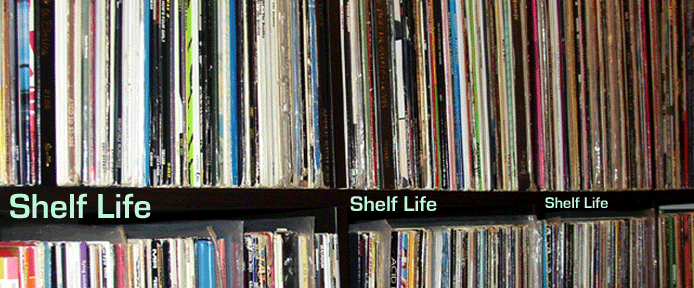Following the breakup of Buffalo Springfield, Young and Stephen Stills each went solo, but Stills soon hooked up with former Byrds resident weirdo
David Crosby and guitarist Graham Nash of English power-popsters
the Hollies to form the appropriately-named Crosby, Stills & Nash. The trio recorded
a decent album of middling suburban ex-hippie folk rock that sold approximately one trillion bazillion copies, and made the group even bigger stars than they already were, and arguably kick-started the unfortunate supergroup trend that
continues to this day.
I'm not certain when Young began playing with them, but he was with them at Woodstock, which was their second public appearance as a group. Shortly thereafter he began touring with them, and Crosby, Stills & Nash eventually became Crosby, Stills, Nash & Young. According to Young's biography, the trio basically had to beg the reluctant Young to join up with them, which, if true, demonstrates their immense regard for his talent. Young had two average-selling solo albums to his credit; CSN were enormous stars.
The fact that they included an obscure Young original in their Woodstock set list speaks volumes. I have no idea where the song came from, and I don't believe it ever appeared on any of Young's albums. Still, he was able to get the band to agree to play it, and it turns up on the concert's soundtrack album. It's a pleasant enough little pop song, and sounds closer to the style one associates with Woodstock-era bands than most of Young's output at the time.
If you haven't listened to the Woodstock album recently, you're depriving yourself of hours of lousy recordings of mediocre performances by such luminaries of rock history as Canned Heat, Country Joe McDonald and Sha-Na-Na. Actually, that's a little harsh; there are some decent cuts on it, but the recording quality is pretty uniformly bad. It's worth hearing once, I suppose, but for the most part it's little more than a reminder that Woodstock's towering place in the history of its era is more for cultural reasons than musical. It's worth noting, incidentally, that CSN's vocals were reportedly so off-key that the group re-recorded some of them in the studio.
Following a tour, the newly-augmented band recorded an album. Déjà vu is terrific, an underrated classic and a model of democratic efficiency. Each member contributes two songs, plus one more collaboration between Stills and Young, and Joni Mitchell's "Woodstock". Young reportedly exercised a great deal of control over the sessions, often strong-arming the others into bending to his will, so it's tempting to credit Young with making the album as good as it is, but I think that's way too easy. There had to be plenty of pride-swallowing by all involved, Young included, to produce an album this lean. Truth be told, I think the secret weapon here is the rhythm section of Dallas Taylor and Greg Reeves, whose tight, propulsive drive carries some of the weaker songs.
But beneath that, the foundation of this album, and what really makes it great, is the songwriting. All four members make the most of their alloted space, and the results range from decent-but-listenable to out-and-out great. Nash's "Teach Your Children" and "Our House" are easily the best-known of the bunch, having been used on numerous television commercials for things like homeowner's insurance in the 1980s, when much of the Woodstock generation was pushing forty. They're a little corny, but they hold up pretty well. Stills's "Carry On" is a strong opener; Crosby's "I Almost Cut My Hair" is a stone(r) classic.
Young's "Helpless" would become one of his better-known songs, but the other, "Country Girl", gets lost in the shuffle, and it's his most ambitious composition since his work with Jack Nitzsche. It's actually billed as a three-part suite; the "chapters" are titled:
- Whiskey Boot Hill
- Down, Down, Down
- "Country Girl" (I Think You're Pretty) [punctuation sic]
The song starts out mournful and uncertain, the melodrama deepened by the somewhat pompous production. By the end the song swells to an epic finale, complete with an organ part that threatens to drown out the rest of the song.
Following the overwhelming success of the album, the band ceased their temporary ego-checking and embarked on a bloated victory tour, complete with multiple sold-out dates all over North America, mind-numbingly directionless jam sessions, and the requisite double live album to commemorate the events. 4 Way Street is, with the exception of a few scattered tracks, nearly unlistenable. Thirteen minute version of "Southern Man" sound tempting? It did to me, but I can't sit through it. Taylor and Reeves are not on the album, by the way, and the rhythm section is noticeably inferior. Crazy Horse they're not.
I wanted to post something just for completeness sake, so I've chosen "Ohio" because it's a great song and the performance is one of the least-awful on the album. But for the most part 4 Way is the sound of egos run rampant and fans eating it up, the product of the worst excesses of rock superstardom in the 1970s. No wonder punk happened.
Young knew it, too. Following the tour he quit the group vowing never to work with them until they all went to rehab. The other three, it should be noted, were widely known to consume inhuman volumes of cocaine. Many industry insiders frequently referred to the band by the nickname "the Frozen Noses". No doubt, Young was also tired of sharing the spotlight; he has, after all, a bloated ego of his own.
In an interesting footnote to the CSNY era, David Crosby did finally drag his walrus-lookin' ass through rehab in the 1980s after receiving a new liver. Young kept his word from so many years ago, which is how he got roped into the forgettable American Dream album. He made yet another album with the group several years ago; I've never heard it.
Buy Déjà vu... on vinyl.
Buy Woodstock... on vinyl.
[Don't] buy 4 Way Street... on vinyl.
From my deck to you: Crosby, Stills, Nash & Young - "Sea of Madness" (live), "Country Girl" and "Ohio" (live)

